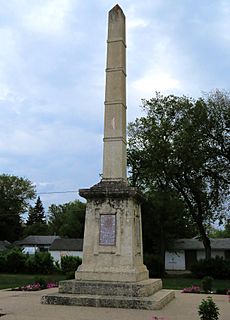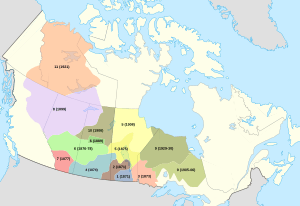Treaty 4 facts for kids
Quick facts for kids Treaty No. 4 between Her Majesty the Queen and the Cree and Saulteaux Tribes of Indians at the Qu'Appelle and Fort Ellice |
|
|---|---|

Pictograph made by Chief Paskwa in 1874 describing Treaty 4
|
|
| Signed | 15–25 September 1874 |
| Location | Fort Qu'Appelle, Fort Ellice |
| Parties | |
| Language | English |
Treaty 4 is an important agreement. It was made between Queen Victoria and the Cree and Saulteaux First Nations people. The land covered by Treaty 4 is mostly in southern Saskatchewan today. It also includes small parts of western Manitoba and southeastern Alberta.
This agreement is also known as the Qu'Appelle Treaty. This is because the first signings happened at Fort Qu'Appelle, North-West Territories. That was on September 15, 1874. More signings, called adhesions, continued until September 1877. Treaty 4 is special because it has a picture story (a pictograph) made by Chief Paskwa. This picture story shows the First Nations' understanding of the treaty.
Contents
Why Was Treaty 4 Needed?
In 1870, the Hudson's Bay Company sold a huge area of land called Rupert's Land. They sold it to the Dominion of Canada for £300,000. This land stretched from the Rocky Mountains to the Great Lakes. It was divided into Manitoba and the North-West Territories.
The Indigenous people who lived on this land were not part of the sale talks. They learned about the deal later. After finding out, they asked for their rights to be recognized. They also wanted payment for their land.
Between 1871 and 1877, Canada signed the first seven of the eleven Numbered Treaties. The Canadian government wanted to gain land from First Nations. This land was for new settlers, farming, and industries.
Prime Minister John A. Macdonald also needed the land for a railway. This railway would go across Canada. It would pass through cities like Regina, Moose Jaw, and Swift Current. The government worried about conflicts with Indigenous people. They thought this could stop progress in the west.
Indigenous people knew that big changes were coming. Their main food source, the bison, was disappearing. More settlers were also arriving. They believed that treaty talks would offer them protection and resources. Both sides worked together during these negotiations.
How Treaty 4 Was Made
Treaty 4 was created on September 15, 1874. It was between some Cree, Saulteaux, and Assiniboine Indigenous people. It was also with "Her Most Gracious Majesty the Queen of Great Britain and Ireland." However, the real decisions were made by Canadian Prime Minister Alexander Mackenzie and his government.
The treaty was signed at Fort Qu’Appelle. At that time, it was a trading post for the Hudson's Bay Company. This is why it's sometimes called the 'Qu’Appelle Treaty'. The land covered by the treaty is in southern Saskatchewan today.
Treaty 4 was the first of the numbered treaties where First Nations joined after it was already written. This meant they had to accept the terms as they were. The main negotiators for Canada were Alexander Morris, David Laird, and William Christie.
These men were chosen by the Canadian government. But they told the Indigenous people that they were making a deal with the Queen herself. Many Métis helped as interpreters during the talks. They also signed Treaty 4 as witnesses.
By 1873, the first three numbered treaties were finished. This opened a clear path for the planned railway. The Canadian government also thought they had enough land for new settlements. So, they did not want to negotiate more treaties right away.
However, Indigenous people who had not signed treaties were worried. The bison were becoming scarce, and settlers kept arriving. They knew that other Indigenous groups had signed treaties. They believed treaties would protect them from changes and hard times. They wanted the same for themselves.
The Prairie Indigenous people told the Canadian government that the land belonged to them. They demanded payment and help. Chief Sweet Grass wrote a letter to Morris. He said, "we heard our lands were sold and we did not like it." He also listed his demands.
Chief Yellow Quill of the Saulteaux bands also took action. Settlers were cutting wood without permission. When he asked for a treaty and got no answer, he put a sign on a church door. It warned settlers not to cut more wood. He said that without a treaty, the wood belonged to the Saulteaux.
Because of this constant pressure, the Canadian government agreed to talk sooner. The disruptions by Indigenous people were slowing down land development.
The Treaty 4 negotiations started slowly and were delayed many times. There were disagreements among the different First Nations groups. They also felt upset with the Canadians. They were angry about the sale of Rupert's Land and the money the Hudson's Bay Company received.
The Canadian negotiators arrived on September 8, 1874. But the First Nations groups could not choose their spokesmen yet. Talks were delayed until September 11. On that day, the Saulteaux sent a message. They were not comfortable holding talks on land that belonged to the Hudson's Bay Company.
Treaty discussions were postponed again. The next day, they met at a camp closer to where the Indigenous people were staying. An Indigenous spokesman started by asking for the £300,000 that the Hudson's Bay Company received. Morris refused this request. He made it clear that the money would not be given.
Once again, the treaty talks were put off. Finally, on September 15, the treaty terms were agreed upon. An interpreter explained the terms to the Indigenous people. Both sides then signed the agreement.
In the years that followed, more groups joined Treaty 4. These additions, called adhesions, happened on:
- September 21, 1874, by Saulteaux.
- September 8, 1875, by Cree, Saulteaux, and Stony Indigenous.
- September 9, 1875, by Cree, Saulteaux, and Stony.
- September 24, 1875, by Cree, Saulteaux, and Stony.
- August 24, 1876, by Cree and Saulteaux.
- September 25, 1877, by Stony.
What Were the Terms of Treaty 4?
The terms of Treaty 4 included several agreements:
- The Canadian Government would create reserves. These were special areas of land chosen by the government.
- Indigenous people could not sell this reserve land. But the government could sell or lease it to help the Indigenous people, only with their permission.
- Schools would be built on each reserve when a teacher was needed.
- Each family of five would receive 640 acres of land.
- Alcohol was not allowed on the reserves.
- Every year, each person (man, woman, and child) would get $5. Each chief would get $25. Each headman would get $15 (except for four headmen per band).
- Also, every chief and headman would get a new set of clothes every three years.
- Powder, shot, bullets, and twine would be given and replaced yearly. This was to help with hunting, fishing, and trapping. These rights were still allowed.
- To help Indigenous people learn farming skills, each family willing to farm would get tools. These included two hoes, one spade, one scythe, and one axe.
- One plough and two harrows would be shared among ten families.
- Bands interested in farming would also get supplies.
- Chiefs would receive a crosscut saw, a pitsaw, a grindstone, five augers, five handsaws, and a box of carpenter tools for the band to use.
- They would also get one pair of oxen, one bull, four cows, and enough wheat, barley, potatoes, and oats for planting.
- The treaty also stated that Indigenous people must accept the treaty. They promised to be "loyal subjects" to the Queen.
- They needed to follow Canadian laws and keep the peace. They also had to tell the government about anyone breaking laws.
- They agreed not to bother settlers or anyone traveling through the land.
- The treaty also said the government could use the surrendered lands. This was for settlement, mining, or other purposes. If the government used reserve land, they had to give an equal amount of non-reserve land back.
Timeline of Treaty 4 Signings
- September 15, 1874: First signings at Fort Qu'Appelle by Cree, Saulteaux, and Assiniboine bands.
- September 21, 1874: Adhesion at Fort Ellice by a Saulteaux band.
- September 8, 1875: Adhesion at Qu'Appelle Lakes by Cree, Saulteaux, and Stony bands.
- September 9, 1875: Another adhesion at Qu'Appelle Lakes by Cree, Saulteaux, and Stony bands.
- September 24, 1875: Adhesion at Swan Lake by Cree, Saulteaux, and Stony bands.
- August 24, 1876: Adhesion at Fort Pelly by Cree and Saulteaux bands.
- September 25, 1877: Adhesion at Fort Walsh by Stony and Assiniboine bands.
First Nations Connected to Treaty 4
Many First Nations are part of or connected to Treaty 4. Here are some of them:
- Manitoba
- Swampy Cree Tribal Council
- West Region Tribal Council
- Gambler First Nation (Treaty 4 signatory, in Treaty 2 territory)
- Pine Creek First Nation (Treaty 4 signatory, in Treaty 2 territory)
- Rolling River First Nation (Treaty 4 signatory, in Treaty 2 territory)
- Tootinaowaziibeeng Treaty Reserve First Nation (Treaty 4 signatory, in Treaty 2 territory)
- Independent
- Waywayseecappo First Nation (Treaty 4 signatory, in Treaty 2 territory)
- Saskatchewan
- File Hills Qu'Appelle Tribal Council
- Carry The Kettle First Nation
- Little Black Bear First Nation
- Muscowpetung First Nation
- Nekaneet First Nation
- Okanese First Nation
- Pasqua First Nation
- Peepeekisis Cree Nation
- Piapot First Nation
- Standing Buffalo First Nation (not a Treaty signatory, but included in Treaty 4)
- Star Blanket Cree Nation
- Wood Mountain First Nation (not a Treaty signatory, but included in Treaty 4)
- Saskatoon Tribal Council
- Touchwood Agency Tribal Council
- Yorkton Tribal Administration
- Coté First Nation
- Kahkewistahaw First Nation
- Keeseekoose First Nation
- Ocean Man First Nation (Treaty 4 signatory, in Treaty 2 territory)
- Sakimay First Nation
- The Key First Nation
- Independent
- Cowessess First Nation
- Ochapowace First Nation
- Pheasant Rump Nakota First Nation (Treaty 4 signatory, in Treaty 2 territory)
- White Bear First Nation (Treaty 4 signatory, in Treaty 2 territory)
- File Hills Qu'Appelle Tribal Council
See also




